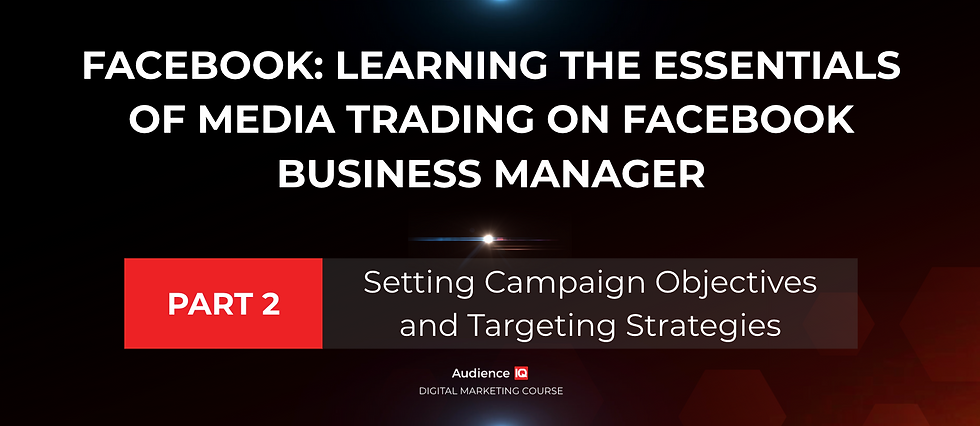Facebook: Learning the Essentials of Media Trading on Facebook Business Manager Part 2: Setting Campaign Objectives and Targeting Strategies
- Sofie Pakula
- Oct 21
- 3 min read

Setting Campaign Objectives and Targeting Strategies
Every high-performing Facebook campaign begins with a clear purpose — a defined goal that guides your targeting, creative, and measurement. Choosing the right objective and pairing it with precise targeting is the foundation of effective media trading on Facebook.
In this second part of our Facebook Media Trading Deep Dive series, we’ll explore how to connect business goals to campaign objectives and apply modern targeting techniques that help your ads reach the right people at the right time.
The Power of Clear Campaign Objectives
Facebook’s campaign objectives determine how the platform’s algorithm delivers your ads and optimizes performance. By selecting the correct objective, you help Facebook identify the right audience and actions to focus on.
Facebook organizes its objectives into three key categories:
Awareness – Increase visibility and brand recognition.
Examples: Brand Awareness, Reach
Consideration – Encourage engagement, traffic, and interaction.
Examples: Traffic, Engagement, Video Views, Lead Generation, Messages
Conversion – Drive valuable actions such as purchases or sign-ups.
Examples: Conversions, Sales, App Installs
Pro Tip: Always align your campaign objective with where your audience is in the funnel. For example, use Reach for new audiences, Engagement for nurturing, and Conversions for retargeting.
Translating Business Goals into Facebook Objectives
Let’s break down how real-world goals map to specific objectives:
Business Goal | Facebook Objective |
Increase website visits | Traffic |
Build brand awareness | Reach |
Boost engagement on posts | Engagement |
Collect new leads or sign-ups | Lead Generation |
Drive online sales | Conversions |
The more specific your goal, the easier it is to measure results and optimize effectively.
Targeting: Reaching the Right Audience
Targeting is what makes Facebook advertising so powerful. It allows you to deliver personalized messages to highly specific audience segments based on their demographics, behaviors, and interests.
1. Core Audiences: Build your audience from scratch using Facebook’s targeting filters:
Demographics: Age, gender, education, job title
Location: Country, city, or radius targeting
Interests & Behaviors: Hobbies, lifestyle, device usage, and purchase behavior
2. Custom Audiences: Reconnect with users who have already interacted with your brand — via your website, app, or customer list. Example: “Users who added to cart but didn’t purchase.”
3. Lookalike Audiences: Use Facebook’s AI to find new people who resemble your best customers. Lookalikes are built from Custom Audiences, helping you scale your reach efficiently.
Modern Targeting Tools: Advantage + and AI-Powered Segmentation
Meta’s Advantage + Audience system combines manual audience inputs with AI-driven expansion, helping advertisers reach people likely to convert — even beyond your defined audience.
This feature automatically analyzes user behavior across Facebook, Instagram, and Audience Network to identify conversion patterns you might otherwise miss.
When to use:
When your campaign has a strong conversion signal (Pixel data, CRM lists, etc.)
When scaling reach beyond your core audiences
Budgeting and Delivery Optimization
Targeting precision means little without the right delivery settings. At the Ad Set level, you’ll define:
Optimization event: The action Facebook should optimize for (e.g., clicks, conversions).
Budget type: Daily vs. lifetime budgets.
Schedule: Start and end dates to control pacing.
Facebook’s algorithm learns over time — allow campaigns to gather sufficient data before making adjustments (at least 5–7 days).
Common Targeting Mistakes to Avoid
Even experienced advertisers fall into these traps:
Targeting audiences that are too broad or too narrow.
Overlapping audiences that compete in the same auction.
Ignoring language and regional differences.
Using interest targeting alone without layering behavioral signals.
To maximize ROI, build audiences that are both specific and scalable, then test multiple variations to see what performs best.
Conclusion: Precision Drives Performance
The perfect blend of the right campaign objective and precise targeting can make or break your Facebook strategy. By aligning goals, audiences, and delivery settings, you create a system where every impression counts and every click moves you closer to conversion.
In the next part of this series, we’ll dive into Creative and Ad Copy Best Practices — how to design visuals and messages that capture attention and drive engagement.
If you would like to dive deeper into this session, you can watch the full lecture here:
Want to see if your targeting strategy is reaching the right audience?
Click below to request a free Insight Audit from Audience-IQ and discover new opportunities to refine your objectives, improve targeting accuracy, and maximize ROI from your Facebook campaigns.
.png)


